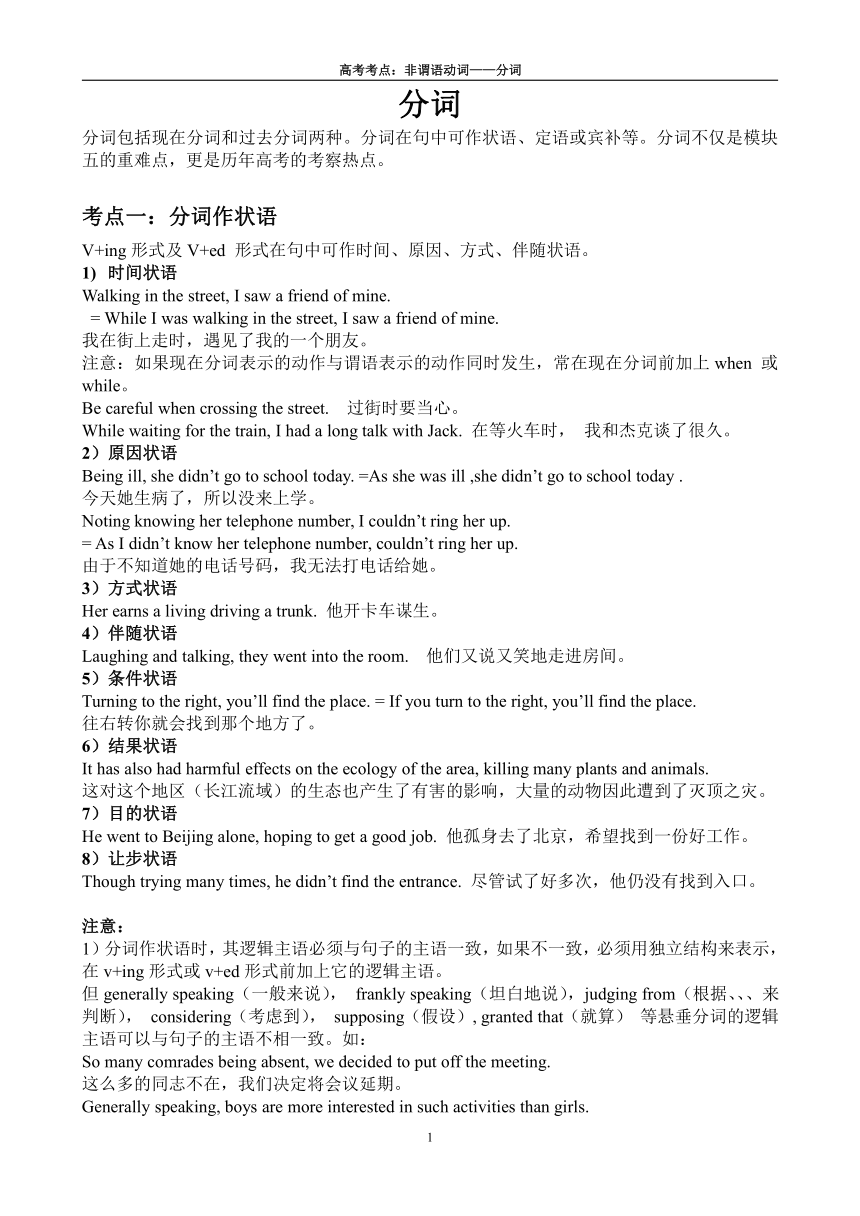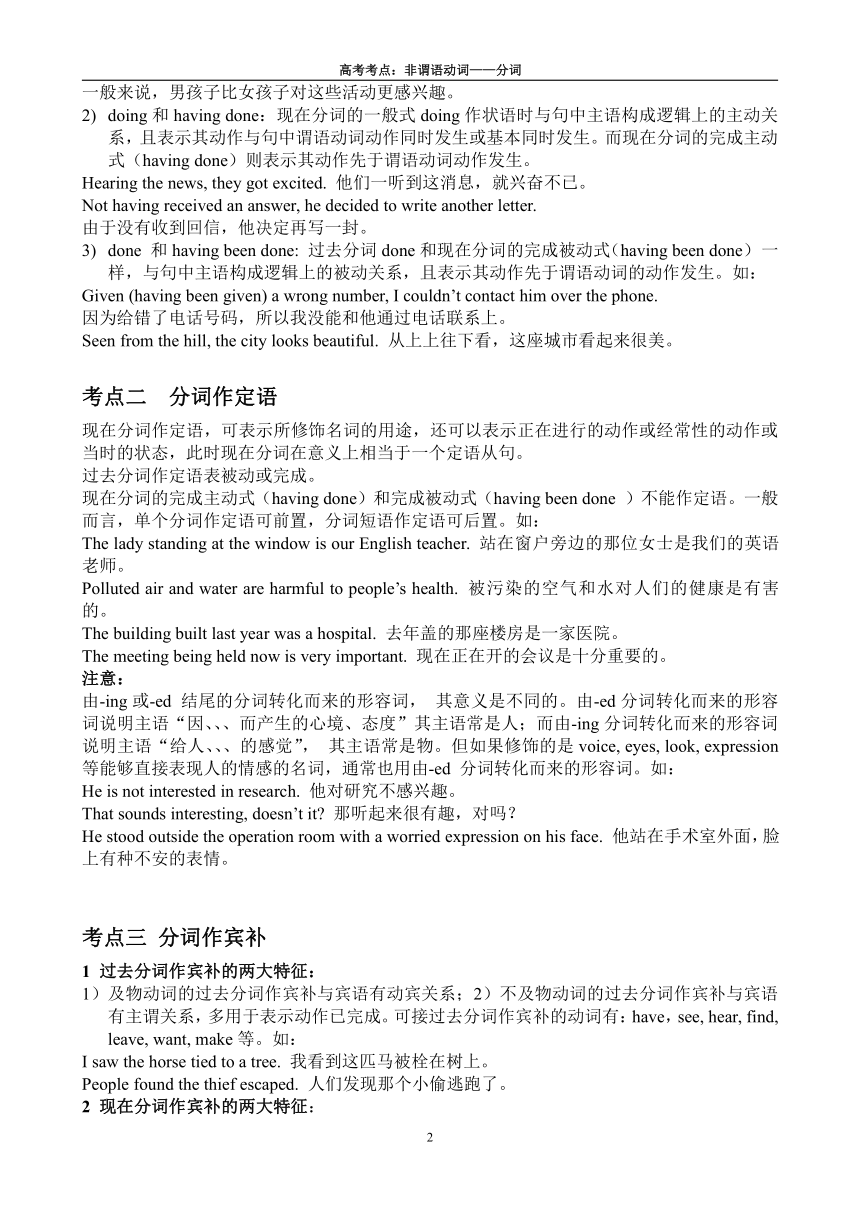非谓语动词 分词
图片预览


文档简介
高考考点:非谓语动词——分词
分词
分词包括现在分词和过去分词两种。分词在句中可作状语、定语或宾补等。分词不仅是模块五的重难点,更是历年高考的考察热点。
考点一:分词作状语
V+ing形式及V+ed 形式在句中可作时间、原因、方式、伴随状语。
时间状语
Walking in the street, I saw a friend of mine.
= While I was walking in the street, I saw a friend of mine.
我在街上走时,遇见了我的一个朋友。
注意:如果现在分词表示的动作与谓语表示的动作同时发生,常在现在分词前加上when 或 while。
Be careful when crossing the street. 过街时要当心。
While waiting for the train, I had a long talk with Jack. 在等火车时, 我和杰克谈了很久。
2)原因状语
Being ill, she didn’t go to school today. =As she was ill ,she didn’t go to school today .
今天她生病了,所以没来上学。
Noting knowing her telephone number, I couldn’t ring her up.
= As I didn’t know her telephone number, couldn’t ring her up.
由于不知道她的电话号码,我无法打电话给她。
3)方式状语
Her earns a living driving a trunk. 他开卡车谋生。
4)伴随状语
Laughing and talking, they went into the room. 他们又说又笑地走进房间。
5)条件状语
Turning to the right, you’ll find the place. = If you turn to the right, you’ll find the place.
往右转你就会找到那个地方了。
6)结果状语
It has also had harmful effects on the ecology of the area, killing many plants and animals.
这对这个地区(长江流域)的生态也产生了有害的影响,大量的动物因此遭到了灭顶之灾。
7)目的状语
He went to Beijing alone, hoping to get a good job. 他孤身去了北京,希望找到一份好工作。
8)让步状语
Though trying many times, he didn’t find the entrance. 尽管试了好多次,他仍没有找到入口。
注意:
1)分词作状语时,其逻辑主语必须与句子的主语一致,如果不一致,必须用独立结构来表示,在v+ing形式或v+ed形式前加上它的逻辑主语。
但generally speaking(一般来说), frankly speaking(坦白地说),judging from(根据、、、来判断), considering(考虑到), supposing(假设), granted that(就算) 等悬垂分词的逻辑主语可以与句子的主语不相一致。如:
So many comrades being absent, we decided to put off the meeting.
这么多的同志不在,我们决定将会议延期。
Generally speaking, boys are more interested in such activities than girls.
一般来说,男孩子比女孩子对这些活动更感兴趣。
doing和having done:现在分词的一般式doing作状语时与句中主语构成逻辑上的主动关系,且表示其动作与句中谓语动词动作同时发生或基本同时发生。而现在分词的完成主动式(having done)则表示其动作先于谓语动词动作发生。
Hearing the news, they got excited. 他们一听到这消息,就兴奋不已。
Not having received an answer, he decided to write another letter.
由于没有收到回信,他决定再写一封。
done 和having been done: 过去分词done和现在分词的完成被动式(having been done) 一样,与句中主语构成逻辑上的被动关系,且表示其动作先于谓语动词的动作发生。如:
Given (having been given) a wrong number, I couldn’t contact him over the phone.
因为给错了电话号码,所以我没能和他通过电话联系上。
Seen from the hill, the city looks beautiful. 从上上往下看,这座城市看起来很美。
考点二 分词作定语
现在分词作定语,可表示所修饰名词的用途,还可以表示正在进行的动作或经常性的动作或当时的状态,此时现在分词在意义上相当于一个定语从句。
过去分词作定语表被动或完成。
现在分词的完成主动式(having done)和完成被动式(having been done )不能作定语。一般而言,单个分词作定语可前置,分词短语作定语可后置。如:
The lady standing at the window is our English teacher. 站在窗户旁边的那位女士是我们的英语老师。
Polluted air and water are harmful to people’s health. 被污染的空气和水对人们的健康是有害的。
The building built last year was a hospital. 去年盖的那座楼房是一家医院。
The meeting being held now is very important. 现在正在开的会议是十分重要的。
注意:
由-ing或-ed 结尾的分词转化而来的形容词, 其意义是不同的。由-ed分词转化而来的形容词说明主语“因、、、而产生的心境、态度”其主语常是人;而由-ing分词转化而来的形容词说明主语“给人、、、的感觉”, 其主语常是物。但如果修饰的是voice, eyes, look, expression等能够直接表现人的情感的名词,通常也用由-ed 分词转化而来的形容词。如:
He is not interested in research. 他对研究不感兴趣。
That sounds interesting, doesn’t it 那听起来很有趣,对吗?
He stood outside the operation room with a worried expression on his face. 他站在手术室外面,脸上有种不安的表情。
考点三 分词作宾补
1 过去分词作宾补的两大特征:
及物动词的过去分词作宾补与宾语有动宾关系;2)不及物动词的过去分词作宾补与宾语有主谓关系,多用于表示动作已完成。可接过去分词作宾补的动词有:have,see, hear, find, leave, want, make等。如:
I saw the horse tied to a tree. 我看到这匹马被栓在树上。
People found the thief escaped. 人们发现那个小偷逃跑了。
2 现在分词作宾补的两大特征:
1)宾语与现在分词有主谓关系;2)现在分词所表示的动作正在进行。
可接现在分词作宾补的动词有:have, see, hear, find, get, leave, notice, watch, keep, start, set, catch, smell, feel, send, listen to, look at等。如:
The old man heard the cock crowing.这位老人听到公鸡在打鸣。
Do you hear someone knocking at the door 你听到有人在敲门吗?
考点四 现在分词的时态和语态
过去分词只有一种形式,而现在分词则有时态和语态的变化。如下表所示:
主动形式 被动形式
一般式 doing being done
完成式 having done having been done
注意:
1 现在分词的一般式:即现在分词所表示的动作和主句的谓语动词所表示的动作基本同时发生或现在分词的动作正在发生。如:
Hearing the bell, the students entered the classroom. 听见铃声,学生们进入教室。
(“听见”“和进入”两个动作基本同时发生)
The building being built now is our new library. 现在正在建设中的这幢大楼是我们的新图书馆。(being built 为现在分词的被动式形式,表示动作正在进行之中。)
2 现在分词的完成式:即现在分词所表示的动作在主句的谓语动词的动作之前就已经发生。如:
Having done the work, he went home. 完成了工作,他就回家了。(“完成”这个动作在“回家”这个动作之前发生)
Having been warned many times, they became more careful in doing the job.被警告多次之后,他们更加小心地做这份工作。(“警告”这个动作在“变得更加小心”这个动作之前发生。)
特别提示:
现在分词的完成式以及现在分词的完成被动式通常不能作定语修饰名词。如不能说:I have heard of the accident having happened yesterday. 而通常应该用定语从句代替:I have heard of the accident that happened yesterday. 我已经听说了昨天发生的事故。
(模块五U1——U3)
应试技巧
1 掌握方法规律
从现在分词在句中所作成分上掌握其基本用法。
We didn’t find Mr. Black _______ the lecture.
No one had told him about _______ a lecture the following day.
A to attend; there to be B attending; there being
C attended; there had D attend; there was
答案:B
点拨:第一空attending为及物动词,表示主动。To do 不定式常表示未发生的动作,排除A项,过去分词attended表示被动意义不成立。 第二空about后应为名词或动名词, there being 是there be 的动名词形式,所以选B.
现在分词作状语时,从其一般式与完成式入手掌握其用法。
The wind was blowing harder and harder, _______ the waves on the lake higher.
A to get B having got C getting D having been got
答案:C
点拨:本句中应用分词短语作结果状语。也由此可知get这一动作晚于主句blow,或与blow几乎同时发生,故不用其完成形式,而用一般式。
从现在分词的主被动形式上把握其用法
It is hoped that education reform _______ in our country at present will bring the ______ result to students.
A carried out; desiring B carrying out; desired C to carry out; desired
D being carried out; desired
答案:D
点拨:第一空修饰education reform, 为被动关系,而且有状语at present 来修饰, 因此用being carried out 表进行被动,第二空desired相当于形容词
PAGE
4
分词
分词包括现在分词和过去分词两种。分词在句中可作状语、定语或宾补等。分词不仅是模块五的重难点,更是历年高考的考察热点。
考点一:分词作状语
V+ing形式及V+ed 形式在句中可作时间、原因、方式、伴随状语。
时间状语
Walking in the street, I saw a friend of mine.
= While I was walking in the street, I saw a friend of mine.
我在街上走时,遇见了我的一个朋友。
注意:如果现在分词表示的动作与谓语表示的动作同时发生,常在现在分词前加上when 或 while。
Be careful when crossing the street. 过街时要当心。
While waiting for the train, I had a long talk with Jack. 在等火车时, 我和杰克谈了很久。
2)原因状语
Being ill, she didn’t go to school today. =As she was ill ,she didn’t go to school today .
今天她生病了,所以没来上学。
Noting knowing her telephone number, I couldn’t ring her up.
= As I didn’t know her telephone number, couldn’t ring her up.
由于不知道她的电话号码,我无法打电话给她。
3)方式状语
Her earns a living driving a trunk. 他开卡车谋生。
4)伴随状语
Laughing and talking, they went into the room. 他们又说又笑地走进房间。
5)条件状语
Turning to the right, you’ll find the place. = If you turn to the right, you’ll find the place.
往右转你就会找到那个地方了。
6)结果状语
It has also had harmful effects on the ecology of the area, killing many plants and animals.
这对这个地区(长江流域)的生态也产生了有害的影响,大量的动物因此遭到了灭顶之灾。
7)目的状语
He went to Beijing alone, hoping to get a good job. 他孤身去了北京,希望找到一份好工作。
8)让步状语
Though trying many times, he didn’t find the entrance. 尽管试了好多次,他仍没有找到入口。
注意:
1)分词作状语时,其逻辑主语必须与句子的主语一致,如果不一致,必须用独立结构来表示,在v+ing形式或v+ed形式前加上它的逻辑主语。
但generally speaking(一般来说), frankly speaking(坦白地说),judging from(根据、、、来判断), considering(考虑到), supposing(假设), granted that(就算) 等悬垂分词的逻辑主语可以与句子的主语不相一致。如:
So many comrades being absent, we decided to put off the meeting.
这么多的同志不在,我们决定将会议延期。
Generally speaking, boys are more interested in such activities than girls.
一般来说,男孩子比女孩子对这些活动更感兴趣。
doing和having done:现在分词的一般式doing作状语时与句中主语构成逻辑上的主动关系,且表示其动作与句中谓语动词动作同时发生或基本同时发生。而现在分词的完成主动式(having done)则表示其动作先于谓语动词动作发生。
Hearing the news, they got excited. 他们一听到这消息,就兴奋不已。
Not having received an answer, he decided to write another letter.
由于没有收到回信,他决定再写一封。
done 和having been done: 过去分词done和现在分词的完成被动式(having been done) 一样,与句中主语构成逻辑上的被动关系,且表示其动作先于谓语动词的动作发生。如:
Given (having been given) a wrong number, I couldn’t contact him over the phone.
因为给错了电话号码,所以我没能和他通过电话联系上。
Seen from the hill, the city looks beautiful. 从上上往下看,这座城市看起来很美。
考点二 分词作定语
现在分词作定语,可表示所修饰名词的用途,还可以表示正在进行的动作或经常性的动作或当时的状态,此时现在分词在意义上相当于一个定语从句。
过去分词作定语表被动或完成。
现在分词的完成主动式(having done)和完成被动式(having been done )不能作定语。一般而言,单个分词作定语可前置,分词短语作定语可后置。如:
The lady standing at the window is our English teacher. 站在窗户旁边的那位女士是我们的英语老师。
Polluted air and water are harmful to people’s health. 被污染的空气和水对人们的健康是有害的。
The building built last year was a hospital. 去年盖的那座楼房是一家医院。
The meeting being held now is very important. 现在正在开的会议是十分重要的。
注意:
由-ing或-ed 结尾的分词转化而来的形容词, 其意义是不同的。由-ed分词转化而来的形容词说明主语“因、、、而产生的心境、态度”其主语常是人;而由-ing分词转化而来的形容词说明主语“给人、、、的感觉”, 其主语常是物。但如果修饰的是voice, eyes, look, expression等能够直接表现人的情感的名词,通常也用由-ed 分词转化而来的形容词。如:
He is not interested in research. 他对研究不感兴趣。
That sounds interesting, doesn’t it 那听起来很有趣,对吗?
He stood outside the operation room with a worried expression on his face. 他站在手术室外面,脸上有种不安的表情。
考点三 分词作宾补
1 过去分词作宾补的两大特征:
及物动词的过去分词作宾补与宾语有动宾关系;2)不及物动词的过去分词作宾补与宾语有主谓关系,多用于表示动作已完成。可接过去分词作宾补的动词有:have,see, hear, find, leave, want, make等。如:
I saw the horse tied to a tree. 我看到这匹马被栓在树上。
People found the thief escaped. 人们发现那个小偷逃跑了。
2 现在分词作宾补的两大特征:
1)宾语与现在分词有主谓关系;2)现在分词所表示的动作正在进行。
可接现在分词作宾补的动词有:have, see, hear, find, get, leave, notice, watch, keep, start, set, catch, smell, feel, send, listen to, look at等。如:
The old man heard the cock crowing.这位老人听到公鸡在打鸣。
Do you hear someone knocking at the door 你听到有人在敲门吗?
考点四 现在分词的时态和语态
过去分词只有一种形式,而现在分词则有时态和语态的变化。如下表所示:
主动形式 被动形式
一般式 doing being done
完成式 having done having been done
注意:
1 现在分词的一般式:即现在分词所表示的动作和主句的谓语动词所表示的动作基本同时发生或现在分词的动作正在发生。如:
Hearing the bell, the students entered the classroom. 听见铃声,学生们进入教室。
(“听见”“和进入”两个动作基本同时发生)
The building being built now is our new library. 现在正在建设中的这幢大楼是我们的新图书馆。(being built 为现在分词的被动式形式,表示动作正在进行之中。)
2 现在分词的完成式:即现在分词所表示的动作在主句的谓语动词的动作之前就已经发生。如:
Having done the work, he went home. 完成了工作,他就回家了。(“完成”这个动作在“回家”这个动作之前发生)
Having been warned many times, they became more careful in doing the job.被警告多次之后,他们更加小心地做这份工作。(“警告”这个动作在“变得更加小心”这个动作之前发生。)
特别提示:
现在分词的完成式以及现在分词的完成被动式通常不能作定语修饰名词。如不能说:I have heard of the accident having happened yesterday. 而通常应该用定语从句代替:I have heard of the accident that happened yesterday. 我已经听说了昨天发生的事故。
(模块五U1——U3)
应试技巧
1 掌握方法规律
从现在分词在句中所作成分上掌握其基本用法。
We didn’t find Mr. Black _______ the lecture.
No one had told him about _______ a lecture the following day.
A to attend; there to be B attending; there being
C attended; there had D attend; there was
答案:B
点拨:第一空attending为及物动词,表示主动。To do 不定式常表示未发生的动作,排除A项,过去分词attended表示被动意义不成立。 第二空about后应为名词或动名词, there being 是there be 的动名词形式,所以选B.
现在分词作状语时,从其一般式与完成式入手掌握其用法。
The wind was blowing harder and harder, _______ the waves on the lake higher.
A to get B having got C getting D having been got
答案:C
点拨:本句中应用分词短语作结果状语。也由此可知get这一动作晚于主句blow,或与blow几乎同时发生,故不用其完成形式,而用一般式。
从现在分词的主被动形式上把握其用法
It is hoped that education reform _______ in our country at present will bring the ______ result to students.
A carried out; desiring B carrying out; desired C to carry out; desired
D being carried out; desired
答案:D
点拨:第一空修饰education reform, 为被动关系,而且有状语at present 来修饰, 因此用being carried out 表进行被动,第二空desired相当于形容词
PAGE
4
